
Kash Gill, who grew up as a farm worker, will be sworn in today as Yuba City’s first Punjabi-American mayor. As many of you know, Yuba City (often referred to as the pindh of California), has a large Punjabi Sikh population. Just last weekend, 75,000 people gathered in Yuba City for the annual Nagar Kirtan. It is perhaps not surprising, therefore, that finally a Punjabi-American will be taking the seat of mayor. The event does, however, signify a signficiant step for a community that makes up about 12 percent of the population in Yuba City. The story also embodies the dream, which many immigrant communities carry with them – that by working hard and perservering, anything is possible.
“You’d never think you’d be picking peaches one day and the next day you’re the mayor of Yuba City,” he said. “That’s why we call it the land of opportunity.” After moving to the United States when he was 3 years old, Gill’s parents stressed that education was the path to leaving the life of farm laboring. [link]
Gill said his priority will be to improve flood protection for the community, reduce gang activity and offer opportunities for young residents. It should be added, that in Yuba City the mayor is chosen on a rotation system and while many of the comments (in the linked article) do discuss his Punjabi-American background, many more are focused on discussing his priorities and how they will benefit the people of Yuba City – as they should be.
Note: The Appeal-Democrat is hosting a live streaming video tonight of City Councilman Kash Gill being sworn in as mayor of Yuba City at www.appealdemocrat.com.
 This weekend Sikhlens will be presenting its annual Sikh Art and Film Festival 2009. The film festival showcases the best in Sikh movie-making talents from around the globe. It also presents a forum for aspiring Sikh artists to also come and display their burgeoning talents. A few book launches are planned with a particular emphasis on children’s books. Authors of A Lion’s Mane and The Royal Falcon are planned to be in attendance to do a live reading.
This weekend Sikhlens will be presenting its annual Sikh Art and Film Festival 2009. The film festival showcases the best in Sikh movie-making talents from around the globe. It also presents a forum for aspiring Sikh artists to also come and display their burgeoning talents. A few book launches are planned with a particular emphasis on children’s books. Authors of A Lion’s Mane and The Royal Falcon are planned to be in attendance to do a live reading.
The inaugural Sikh Art and Film Festival will be held at the historic Egyptian Theatre in Hollywood, CA on November 13-15th.
In previous articles on The Langar Hall, I have written about how certain Sikh-film haters groan in jealousy and spew hatred, about the Sikhs’ taking advantage of new forms of media. Such efforts in the community should be encouraged and more platforms created.
The weekend features a number of different clusters, highlighting issues on the youth, creative Sikhs, short films, feature films, and even Remembering 1984. The Remembering 1984 cluster on Sunday afternoon will be co-hosted with the Jakara Movement in conjunction with it’s Visions of Truth film series.
So whether you come for the entire weekend, make it out to just one cluster (at $15 pre-sale, you won’t find a better price), or at least to Sunday’s mela, check the schedule, check out the films, and make sure you come out and support Sikh arts! We’ll be in attendance and will post on our experience after the event.
 This past weekend was the 30th Annual Yuba City Nagar Kirtan (sometimes called the Sikh Parade). Thousands from all over California and beyond gathered for the weekend, doubling the population of sleepy Yuba City.
This past weekend was the 30th Annual Yuba City Nagar Kirtan (sometimes called the Sikh Parade). Thousands from all over California and beyond gathered for the weekend, doubling the population of sleepy Yuba City.
An estimated 75,000 people filled Tierra Buena and Butte House roads before the beginning of the parade, one of the largest annual gatherings of Sikhs anywhere outside Asia.[link]
We had mentioned before the float built by the Sikh Students Collaborative. The Appeal Democrat, Yuba City’s own newspaper, made special note of the float that seemed to have attracted plenty of conversation and provided fruits for conversation:
More floats followed, from businesses, school ethnic clubs and charities such as the American Red Cross’ local chapter. Some floats had a political message, such as one from a group of Sikh college students that warned of oppression against Sikhs in their native India.
Two men stood on the float with their heads positioned inside nooses, while words read, “A community will never forget.”[link]
Along with the float, the first annual Yuba City Youth Lecture and Discussion was conducted. Overall the weekend was a great success and too many of us are still exhausted. Special thanks to ALL those SSAs that lent their support and especially ALL OF THE VOLUNTEERS that were out until 2am working on the float. Leave your comments or thoughts. Below the link, see some pictures from the float.
20,000 Butchered in Delhi
25,000 Made “Disappeared” in Punjab
A Community Bruised
A Diaspora Tarnished
STILL WE RISE
A Nation Never Forgets
Remember 1984
On The Langar Hall, the fight for justice is rarely far from our minds. While justice remains elusive and mass-murderers promoted, the community suffers, but not in silence. In this 25th year of the Indian Government-sponsored pogroms, we bear witness to that genocide. We remember not only the lives lost, but call for accountability so that events such as Delhi 1984, Gujarat 2002, and the numerous human rights abuses that occur everyday in the territory that is India are not forgotten. The Indian elite may see the country as a rising economic star, but without political rights, freedoms, and a genuine commitment to justice, slogans such as “Indian Shining” fall on deaf ears.
Here is one such event that inspires us to remember:

Below the fold, see a list of upcoming events in your community. Participate, contribute, stand in solidarity – Remember 1984.
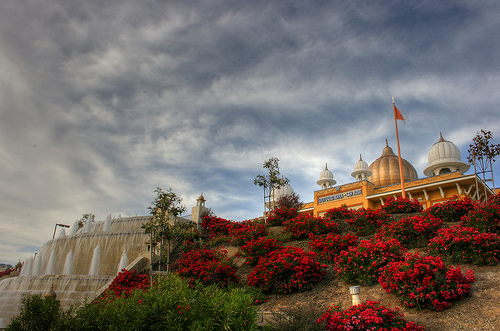 Every other city we go….
Every other city we go….
The story repeats itself.
There are 2 Sikhs. They decide to build a Gurdwara. First comes love, then they disparage, next comes litigation and community image damage.
The most recent editions – Bakersfield and San Jose.
Last week, I wrote a wrap-up about the 10th Annual Jakara Movement Conference. Sikh Knowledge, a previously featured artist, wrote his thoughts on his blog.
However, an especially important post was written by Pashaura Singh Dhillon. For those that are regular langa(r)-eaders, then you need no introduction. In a post during last year’s presidential election, I introduced a Fresno Punjabi landmark – one of our many great poets.
At last week’s Jakara Movement Conference, Pashaura Singh delivered a powerful poem at the farewell banquet. On his own blog, he introduces the piece, written with a contemporary problem using a traditional Mirza meter. I quote at length:
I was invited to share a poem I wrote at the closing banquet of Jakara Movement. Jakara began in 2000 with a mission to call the next generation of Sikhs from all places, backgrounds and points of view to reflect on their past and prepare for the future. In 2009, they came together as the next generation of Sikhs to continue the process of empowering, engaging , and educating the Sikh community.
Kanwar Anit Singh Saini (Sikh Knowledge) and Kanwar Singh (Humble the Poet), two Canadian rappers and participants of 2009’s Jakara said it best. “1984 is all around us. It is happening in Rwanda. It is happening in Palestine. We should try to find connections with people who are also victims because then the minority becomes the majority.”
But I was not there to repeat what had already been reported or was going to be reported on this subject. As a poet I wanted to invite them to a different plane, whereby they not only take the message of what happened to the Sikhs 25 years ago but also what is happening all around the world today and how it relates to us all. A big picture where these compounded atrocities and excesses not only of humans on humans that are happening everyday but also collectively of humans on this planet Earth, which threatens its very survival. The victim of human’s inhumanity the Earth pleads with the princess of the Skies whose domain the fugitive from Earth is now so impatient to intrude. Without further adieu, here is “Umber Di Shehzadi De Naa: To the Princess of the Skies”

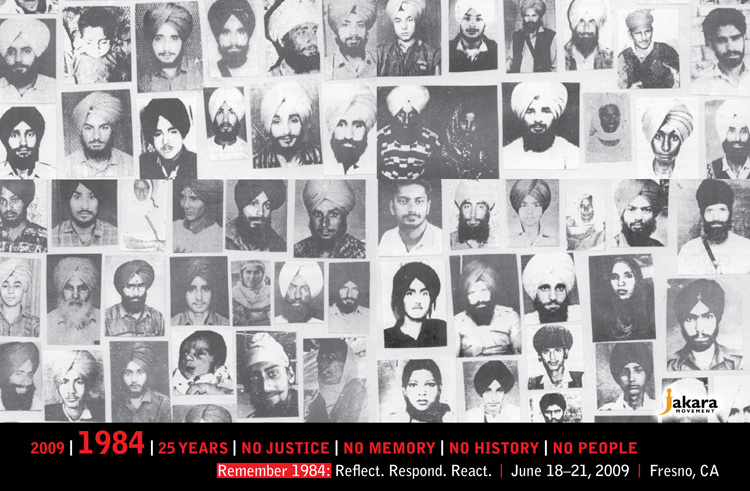
The topic of 1984 is hardly new in The Langar Hall and despite protestations from some amnesia-desiring commenters, we will not forget the Shaheeds of Darbar Sahib, the pograms in Delhi, the Ghallughara against the Sikhs from 1978-1995, or even the continuing impunity that continues today.
We have highlighted many events in the past and we will contine to do so.
In that spirit, I strongly urge TLH readers to attend this year’s Jakara Movement conference in Fresno, CA from June 18-21st. A number of invited guests’ names will be announced in the upcoming week. The title of the conference is “Remember 1984: reflect. respond. react.”
2009 | 1984 | 25 years | No justice | No memory | No history | No people
Despite the fact that many wish to forget the events that befell and have shaped the Sikh Nation, it is vital for the ‘next generation of Sikhs’ to be aware of our past and understand how it shapes our present and our future. While twenty-five years have passed since the attack on our sacred home, much has changed and much has remained the same. For the Nishan Sahib of our Nation to remain tall, it is for us to study our history, remember the past, and continue the fight for justice.
This year at Jakara, we will Remember 1984 and celebrate those Kaurs and Singhs that made the ultimate sacrifice for our Qaum.
Join us in Fresno as we Remember 1984: Reflect. Respond. React.
Register here TODAY and avoid a late fee. Below the fold you’ll find the agenda. See you there!
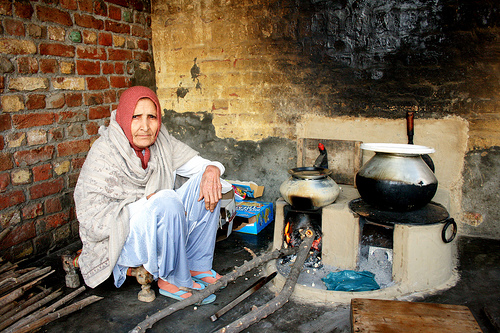
While driving home from a friend’s house one night I noticed something out of the corner of my eye as I passed the rows of darkened homes in his neighborhood. One garage door on the block was open and the garage lights were on, but there were no cars inside. Instead, there was an older Mata/Mai/Bibi/Bebe standing in front of a stove making roti, while a younger lady was dishing out what must have been some dal/sabzi.
The site was kinda cool and I had to resist the urge to stop my car and take a picture to post here – for fear of looking like a creepy weirdo. I did, however, think about it all the way home. What made it worth thinking about for a 10-minute drive is simple: it took me back to Punjab, where many farming families have two kitchens – one inside and one outside (where a bulk of the cooking is done).
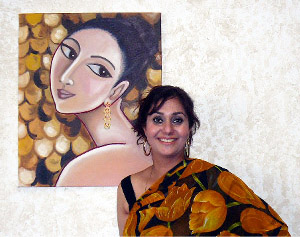 As International Women’s Day approaches us this weekend, I wanted to highlight the story of one woman who left a life of violence to a home of comfort built from creativity. Tanya Momi, a Bay Area South Asian woman from Chandigarh, is a painter and owner of “Spoil-Me Salon”, who left a long-term abusive marriage where she was treated like an “educated maid”. On March 8th her work will be launched in San Francisco as part of Amnesty International’s Stop Violence Against Women’s traveling art exhibit.
As International Women’s Day approaches us this weekend, I wanted to highlight the story of one woman who left a life of violence to a home of comfort built from creativity. Tanya Momi, a Bay Area South Asian woman from Chandigarh, is a painter and owner of “Spoil-Me Salon”, who left a long-term abusive marriage where she was treated like an “educated maid”. On March 8th her work will be launched in San Francisco as part of Amnesty International’s Stop Violence Against Women’s traveling art exhibit.
Vidya Pradhan writes:
“Tanya Momi rebuilt her life after a traumatic marriage and divorce and in her own quiet way she helps other women do the same. “Women come into my life through the salon,” she says. “They are like the missing puzzle pieces of my life.” Through her work in the salon and her paintings she reaches out to offer comforting messages of hope and renewal.”
 Assemblyman Warren Furutani (D-Long Beach) has introduced a new bill requiring awareness trainings and instruction on how to approach Sikhs for California’s law enforcement agencies and officers. If passed, California, which is home to the oldest Sikh gurdwara in the U.S. (Stockton) and one of the largest Sikh populations in the country, would take affirmative steps to ensure that the rhetoric around national security is not inappropriately utilized to prevent Sikhs from the free and fully practice of our faith.
Assemblyman Warren Furutani (D-Long Beach) has introduced a new bill requiring awareness trainings and instruction on how to approach Sikhs for California’s law enforcement agencies and officers. If passed, California, which is home to the oldest Sikh gurdwara in the U.S. (Stockton) and one of the largest Sikh populations in the country, would take affirmative steps to ensure that the rhetoric around national security is not inappropriately utilized to prevent Sikhs from the free and fully practice of our faith.
Assemblyman Furutani explained the need for this protection specifically in the context of the kirpan:
Since the Sept. 11 terrorist attacks, Sikhs carrying the blade, which they consider sacred, have experienced a sharp increase in prosecutions, according to the legislation, AB 504, that Furutani has introduced.
“The Sikh community should not live in fear of arrest by law enforcement for carrying the kirpan, which is an integral part of their religious faith.” [link]
In light of the horrific experience of the Tagore family in Texas, it sounds like this kind of forward-looking legislation could prevent instances of ignorance-based harassment, or at the very least provide a legal basis for holding police officers accountable to culturally appropriate standards of enforcement for the diverse communities in which they work. The bill will be reviewed in March, and it will be interesting to see if it’s able to gain political traction in the upcoming legislative session.
The Center for Asian American Media (CAAM) is a group working to present stories that convey the “richness and diversity of Asian American experiences” to the broadcast audience. They do this by funding, producing, distributing and exhibiting works in film, television and digital media. One example is this video directed for Mandeep Sethi, a bay area MC. As he says, Where do we go from here, I thought my people would be proud of their heritage and instead they want to bury it.
Also presented by the Center, is the upcoming 27th Asian American Film Festival in San Francisco. For those of you in the area, here are some of the films you might want to catch.
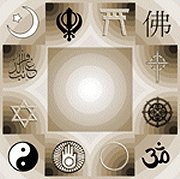 Growing up where I did, singing hymns and listening to the Our Father, Who Art in Heaven prayer were a daily occurrence. There was only one religion taught in my school. It was a point of discontent for those of us who followed other faiths and after years of students petitioning to be exempted from such morning meetings, my school reluctantly made exceptions for us. My school was a public school but it was also in England where separation of church and state did not exist.
Growing up where I did, singing hymns and listening to the Our Father, Who Art in Heaven prayer were a daily occurrence. There was only one religion taught in my school. It was a point of discontent for those of us who followed other faiths and after years of students petitioning to be exempted from such morning meetings, my school reluctantly made exceptions for us. My school was a public school but it was also in England where separation of church and state did not exist.
I don’t have a problem with teaching religion in schools, actually I think religion should be discussed at school but practice should not enforced. I do recognize that this raises the question of Sikh-based schools where religious education is provided in accordance with the Sikh faith. However, I will emphasize that these faith-schools are private schools and children often have a choice to attend those institutions.
It seems that the concept of separation of state and church has in effect reduced the amount of time/effort which is spent on teaching religion in schools. A recent article discusses a school in Modesto, California which has decided that learning about world religions is an important subject and in fact, have even made it a graduation requirement.
Johansen High School in Modesto, California, sounds like any other, until the sacred Hindu sound – “ommmmmm” – vibrates from history teacher Yvonne Taylor’s classroom. Today, she’s talking about Hindu ideas of the cycle of death and rebirth. This nine-week course for ninth graders teaches the fundamental beliefs of Christians, Muslims and Confucianists, as well as Hindus, Buddhists, Sikhs and Jews – all tied in with the history of religious liberty in the United States. [link]
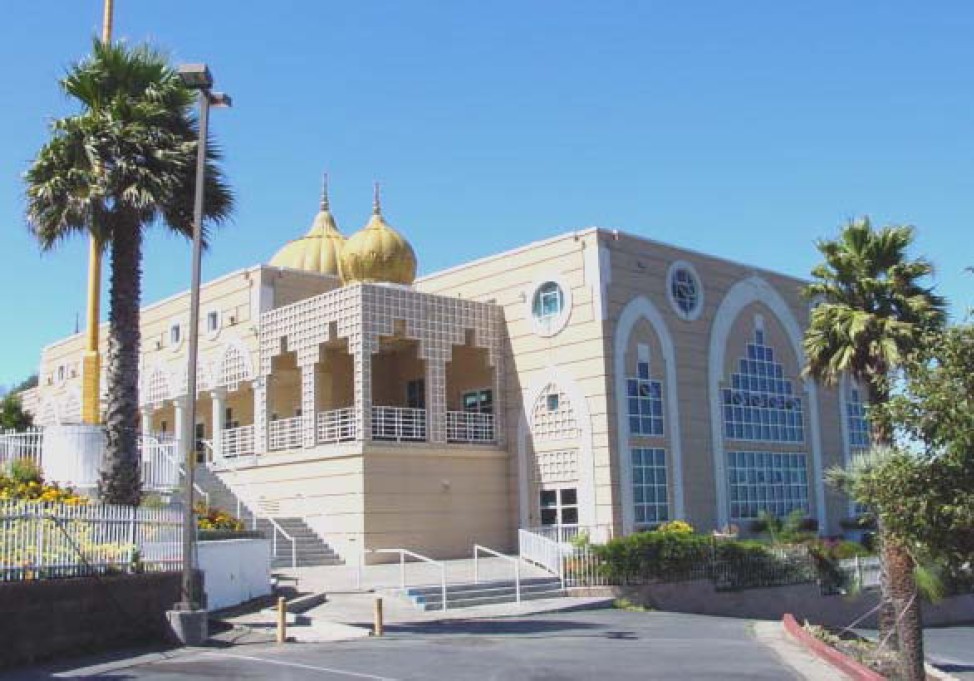 We covered the El Sobrante Gurdwara expansion — and the subsequent PR fallout — a while ago. Earlier this week, the county halted expansion plans pending a further environmental review. Local residents filed a petition for re-review, claiming the “regional service area” proposed in the expansion documents underestimated projected population growth/use in the area:
We covered the El Sobrante Gurdwara expansion — and the subsequent PR fallout — a while ago. Earlier this week, the county halted expansion plans pending a further environmental review. Local residents filed a petition for re-review, claiming the “regional service area” proposed in the expansion documents underestimated projected population growth/use in the area:
The appellants, El Sobrante Valley Planning and Zoning Advisory Committee and Quail Hill Homeowners Association, say the mitigated negative declaration does not adequately address their concerns regarding traffic, parking, noise, possible landslides, drainage, wildlife and emergency vehicle access.
Gurdwara leadership says that community members have it all wrong, though, and that they are off the mark in understanding how regional is defined and what it means for the future of the center.
Sikh leaders said they have spent the past 10 years fine-tuning the project to satisfy the county as well as neighbors.
“We have spent more than half a million dollars” — not including volunteer time and effort — “to comply “… and keep our neighbors advised…”
When we discussed this last time, I asked about the challenges we face explaining our presence and integrating into the fabric of religion in the U.S. We could revisit that conversation, but this time I thought it was curious that the project has been stalled in the face of a staggering economic slowdown in this region. Could this have generated jobs and funding at a time when the area could benefit from economic development? Or was this not worth the end result?
As the economy’s downturn affects millions of North Americans, you wonder how documented/undocumented immigrants are impacted by it; particularly, when many left friends and families in their home-countries for economic opportunities in the West. Maple Leaf Sikh gave us some insight into how the Punjabi Sikh population is being affected in Canada.
Last week, a KGET news report (view below for video report), focused on the undocumented population in California’s Central Valley. Despite economic hard-times in Kern County, its large undocumented population, who are primarily Latino, has no intention of going back to their home-countries. Regardless of soaring unemployment rates, US economic recession, and a major downturn in California’s construction, service, and agriculture industries, many undocumented workers maintain a tremendous amount of faith in the US economy.
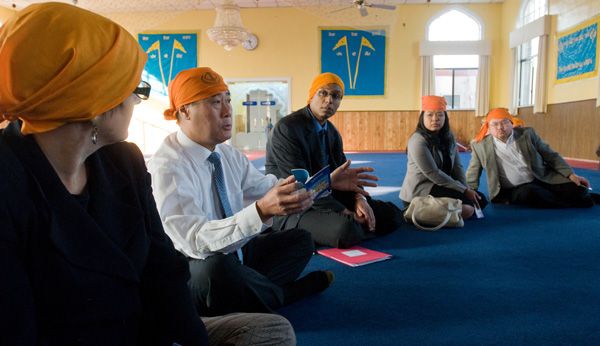
At Stockton’s Sikh Temple on Friday morning, State Sen. Leland Yee, a San Francisco Democrat, asked whether members of the faith identify themselves more as Indians or as Sikhs.
That’s a controversial point, to be honest,” temple representative Sarabjit Singh said.[link]
The question often arises in various discussions. In fact in a recent conversation about the sometimes-called Sikh (pagh salute: GK) Inaugural Ball in DC this week, one commenter lamented:
One thing that I noticed about the Sikhs, is that they always seem to feel underrepresented. By the amount of their rhetoric, a Westerner would probably think that 33% of India is compromised of Sikhs, when in fact, the figure is more like 2%. Also, Sikhs tend to not view themselves as Indians, and apparently, they don’t view themselves as being “desi”. Even this Sikh Inaugural Ball has the headline “Sikhs and Desis Celebrate Obama.” Wait a minute…so Sikhs are exclusive to Desis now?[link]
While driving yesterday I heard about an interesting news story on the local conservative talk radio station. Basically, the Mexican father of a 14 year old daughter was arrested by California authorities for selling his 14 year old daughter’s hand in marriage to an 18 year old man. Apparently in Oaxaca (pronounced Wa-ha-ka), a state in Mexico, such practice is normal.
Marcelino de Jesus Martinez, 36, of Greenfield, California, was arrested Monday and booked into the Monterey County Jail, Greenfield police said in a statement. He faces felony charges of receiving money for causing a person to cohabitate, police said.
Martinez had arranged through a third party to have his daughter marry the older teenager, identified by authorities as Margarito de Jesus Galindo, of Gonzales, California. In exchange, Galindo was to pay Martinez $16,000 and provide him with 160 cases of beer, 100 cases of soda, 50 cases of Gatorade, two cases of wine, and six cases of meat, Greenfield Police Chief Joe Grebmeier told CNN.
In the Oaxacan community, such an agreement is “normal and honorable,” he said. “In California, it’s against the law. [Source]
The story is interesting because the novelty of the situation seems to have forced people to actually think about what it means to be a melting pot or an integrated community.?The questions being asked on the?show?I was listening to were the same questions that are asked of Sikh religious practices: Where do we stop being accommodating and begin enforcing laws that protect people? How do we respect culture and enforce laws?
The dance continues. India’s infamous Central Bureau of Investigation just made a trip to the US to record testimony from two witnesses who identified Jagdish Tytler as an organizer of three days of violence in 1984 against Sikhs in Delhi.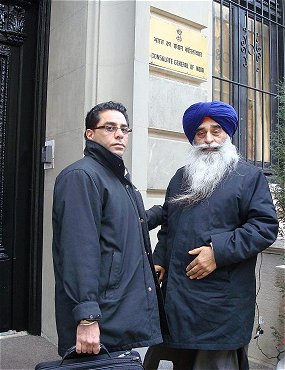
A team from India’s Central Bureau of Investigation came to the U.S. Dec. 22-26 to take testimony from two key witnesses who allege that former Union Minister Jagdish Tytler organized three days of violence against Sikhs in New Delhi 1984, following the assassination of Prime Minister Indira Gandhi. [India West]
Jasbir Singh, one of the men whose testimony was taken, was a witness before the Nanavati Commission in 2004. The Nanavati Commission found that there was sufficient evidence against Tytler to open an investigation against Tytler. However, the CBI closed the investigation last year claiming that it couldn’t find the witnesses.
The Nanavati Commission concluded that sufficient evidence against Tytler existed to launch an investigation. The CBI had closed the case against Tytler — still a prominent member of the Congress party — last September, saying it could not find the witnesses. It reopened the case after several media reported that Jasbir Singh was residing in Fremont, Calif. [India West]
Two steps forward and one step back. Just when you think we’ve made some progress in terms of creating awareness about who we are as Sikhs, you hear of incidents like this. Here’s the story on NBC’s KGET.
We tend to complain a lot. Really, we do. We complain about the lack of activisim by Sikh youth. We complain about not being able to understand Gurbani or be able to do Kirtan. We complain about the disconnect between Sikh elders and Sikh youth. It’s the status quo – to spend time dwelling on what’s wrong in our community rather than celebrate what’s actually going right.
However, in recent years we’ve been seeing an increased number of Sikh student or Sikh youth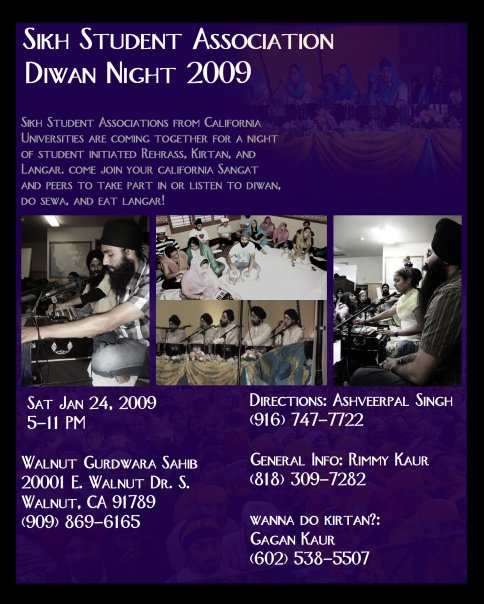 run events – which means it’s becoming clear that the status quo is no longer okay. I think it is not only important, but necessary, for Sikh youth to take more of an active role in their community. So it was refreshing for me to hear about this student initiated event which is being planned in collaboration with the Sikh Student Associations across California. This Diwan Night, which is to be held on January 24th 2009 in Southern California, will bring together Sikh students from across California for a night of Rehraas, Kirtan, Sewa and Langar. It’s important to support these types of initiatives and encourage Sikh youth to participate in coordinating these events. I hope this is one of many student initiated events which brings various organizations together in the hopes of actively involving youth in Sikhi.
run events – which means it’s becoming clear that the status quo is no longer okay. I think it is not only important, but necessary, for Sikh youth to take more of an active role in their community. So it was refreshing for me to hear about this student initiated event which is being planned in collaboration with the Sikh Student Associations across California. This Diwan Night, which is to be held on January 24th 2009 in Southern California, will bring together Sikh students from across California for a night of Rehraas, Kirtan, Sewa and Langar. It’s important to support these types of initiatives and encourage Sikh youth to participate in coordinating these events. I hope this is one of many student initiated events which brings various organizations together in the hopes of actively involving youth in Sikhi.
The event is on January 24th, 2009 from 5-11pm at Walnut Gurdwara. If you would like to participate in Kirtan, call Gagan Kaur at 602 538 5507. For general information, call Rimmy Kaur at 818 309 7282.
I know not whether it is an ‘old tradition‘ or a ‘family tradition’; I only know it seems to be a great tradition. Last 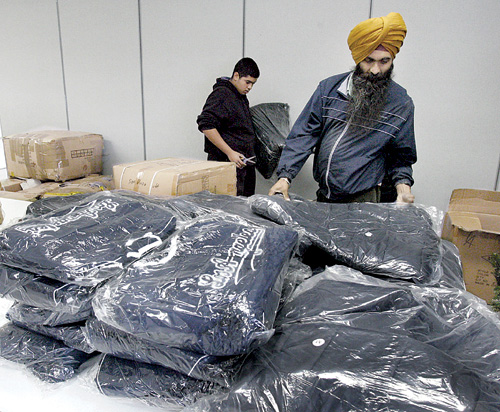 week, Camille bulletin board-ed a winter clothing distribution in Central California being sponsored by Mike Sandhu of Sandhu Brothers Farms.
week, Camille bulletin board-ed a winter clothing distribution in Central California being sponsored by Mike Sandhu of Sandhu Brothers Farms.
The Tracy Press published some pictures of the distribution that saw some 1200 jackets (over $50,000 in value) go out to anyone that needed. Mike stated that this was a family tradition in honor of the 2 youngest Sahibzadas.
“So we do this to keep other children, other families, warm in their honor,” he said. “It’s just something my family has done here for about six years now.”[link]
I hope that other local Sikh sangats take Mike Sandhu and the Tracy Sikh Community’s lead in making such events more regular. More than any donation of rumaals to the Gurdwara, this is one of the best ways to honor the Qaum’s shaheeds.

